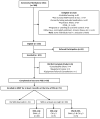Obstructive sleep apnea is more common than central sleep apnea in methadone maintenance patients with subjective sleep complaints
- PMID: 20079978
- PMCID: PMC2859844
- DOI: 10.1016/j.drugalcdep.2009.11.019
Obstructive sleep apnea is more common than central sleep apnea in methadone maintenance patients with subjective sleep complaints
Abstract
Objectives: Opioid-dependent patients treated with methadone have subjective sleep complaints and disrupted sleep on polysomnography (PSG). Previous studies of sleep-disordered breathing (SDB) in this population have focused on central sleep apnea (CSA). Our objectives were to: (1) characterize obstructive sleep apnea (OSA) and CSA in patients in methadone maintenance treatment (MMT) for opioid dependence; (2) examine factors associated with SDB in this population; and (3) investigate whether SDB was related to severity of subjective sleep complaints in MMT patients with subjective sleep disturbances.
Methods: We analyzed OSA and CSA from one night of home PSG in 71 patients who were in MMT for at least 3 months and had a Pittsburgh Sleep Quality Inventory (PSQI) score >5.
Results: OSA (defined as obstructive apnea-hypopnea index (OAHI) > or = 5) was observed in 35.2% of our sample. OSA was associated with higher body mass index, longer duration in MMT, and non-Caucasian race. CSA (defined as central apnea index (CAI) > or = 5) was observed in 14.1% of the sample. CSA was not associated with methadone dose or concomitant drug use. Subjective sleep disturbance measured with the PSQI was not related to OSA or CSA.
Conclusions: SDB was common in this sample of MMT patients and OSA was more common than CSA. Given the lack of association between presence of SDB and severity of subjective sleep difficulties, factors other than sleep apnea must account for complaints of disturbed sleep in this population.
Copyright 2010 Elsevier Ireland Ltd. All rights reserved.
Conflict of interest statement
Figures


Similar articles
-
Subjective daytime sleepiness and daytime function in patients on stable methadone maintenance treatment: possible mechanisms.J Clin Sleep Med. 2008 Dec 15;4(6):557-62. J Clin Sleep Med. 2008. PMID: 19110885 Free PMC article.
-
A narrative review: The effects of opioids on sleep disordered breathing in chronic pain patients and methadone maintained patients.Am J Addict. 2016 Sep;25(6):452-65. doi: 10.1111/ajad.12424. Am J Addict. 2016. PMID: 27554389 Review.
-
Assessing sleep in opioid dependence: a comparison of subjective ratings, sleep diaries, and home polysomnography in methadone maintenance patients.Drug Alcohol Depend. 2011 Jan 15;113(2-3):245-8. doi: 10.1016/j.drugalcdep.2010.08.007. Epub 2010 Sep 17. Drug Alcohol Depend. 2011. PMID: 20850231 Free PMC article.
-
Central sleep apnea in stable methadone maintenance treatment patients.Chest. 2005 Sep;128(3):1348-56. doi: 10.1378/chest.128.3.1348. Chest. 2005. PMID: 16162728
-
Chronic opioid use and central sleep apnea: a review of the prevalence, mechanisms, and perioperative considerations.Anesth Analg. 2015 Jun;120(6):1273-85. doi: 10.1213/ANE.0000000000000672. Anesth Analg. 2015. PMID: 25988636 Review.
Cited by
-
A review of sleep disturbance in adults prescribed medications for opioid use disorder: potential treatment targets for a highly prevalent, chronic problem.Sleep Med. 2021 Aug;84:142-153. doi: 10.1016/j.sleep.2021.05.021. Epub 2021 May 27. Sleep Med. 2021. PMID: 34153796 Free PMC article. Review.
-
Sleep Disorders in Methadone Maintenance Treatment Volunteers and Opium-dependent Patients.Addict Health. 2016 Apr;8(2):84-89. Addict Health. 2016. PMID: 27882205 Free PMC article.
-
Pathogenesis of sleep-disordered breathing in the setting of opioid use: a multiple mediation analysis using physiology.Sleep. 2024 Nov 8;47(11):zsae090. doi: 10.1093/sleep/zsae090. Sleep. 2024. PMID: 38605676 Free PMC article.
-
Clinical Efficacy of Traditional Chinese Medicine, Suan Zao Ren Tang, for Sleep Disturbance during Methadone Maintenance: A Randomized, Double-Blind, Placebo-Controlled Trial.Evid Based Complement Alternat Med. 2015;2015:710895. doi: 10.1155/2015/710895. Epub 2015 Aug 4. Evid Based Complement Alternat Med. 2015. PMID: 26346534 Free PMC article.
-
Sleep reductions associated with illicit opioid use and clinic-hour changes during opioid agonist treatment for opioid dependence: Measurement by electronic diary and actigraphy.J Subst Abuse Treat. 2019 Nov;106:43-57. doi: 10.1016/j.jsat.2019.08.011. Epub 2019 Aug 14. J Subst Abuse Treat. 2019. PMID: 31540611 Free PMC article. Clinical Trial.
References
-
- American Academy of Sleep Medicine. Sleep-related breathing disorders in adults: recommendations for syndrome definition and measurement techniques in clinical research. Report of the American Academy of Sleep Medicine Task Force. Sleep. 1999;22:667–689. - PubMed
-
- BaHammam A. Comparison of nasal prong pressure and thermistor measurements for detecting respiratory events during sleep. Respiration. 2004;71:385–390. - PubMed
-
- Banta-Green CJ, Maynard C, Koepsell TD, Wells EA, Donovan DM. Retention in methadone maintenance drug treatment for prescription-type opioid primary users compared to heroin users. Addiction. 2009;104:775–783. - PubMed
-
- Beck A, Steer R. Manual for the Beck Depression Inventory. Psychological Corporation; San Antonio: 1993.
Publication types
MeSH terms
Substances
Grants and funding
LinkOut - more resources
Full Text Sources
Medical

